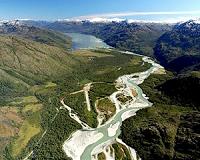| . |  |
. |
Nanjing, China (SPX) May 24, 2011 Hohai University in Nanjing has established a research tradition in hydraulic engineering over the last 95 years. During this time, Hohai has become a first class institution of higher education that focuses on a wide range of engineering subjects including civil engineering and water resources, which are of particular interest. China's hydropower development occurs mainly in the high mountains and canyons of the Qinghai-Tibet plateau in the southwestern provinces. Because of long term geological movement, these areas are subject to high levels of geostress with complex geological conditions. Excavation of dam foundations in these high stress areas immediately destroys the natural stress balance of the rock mass, resulting in degradation of the material's mechanical properties, such as elastic modulus and compression strength, and the forming of a relaxation zone in the rock mass up to a depth of 10-20 m from the free surface. Therefore there is considerable engineering justification in being able to determine the relaxation zone and its influence on the arch dam. At the same time the research results provide a sound design basis for the treatment of foundations. This study uses theoretical orthogonal experiments and numerical analysis methods to analyze the influence of relaxation on the performance of the arch dam at Jinping-I. Three factors were adopted for the orthogonal experiments: the area of mass-height distribution of rock relaxation with respect to the dam height, the depth of rock perpendicular to the foundation, and the extent of the relaxation (the reduction in the magnitude of the elastic modulus of the rock in the relaxation zone). For each factor, four levels were selected for the orthogonal experiment. Since the maximum stress s1 at the upstream face, the maximum stress s3 at the downstream face, the tensile stress at the heel of the dam and the compression stress at the toe of the dam are suitable for characterizing the working behavior of an arch dam, they were chosen as the evolution indices.
The relaxation influence on the upstream and downstream principle stresses The maximum value of s3 downstream is affected to a greater extent by the extent and height of the relaxation, and is more sensitive to the relaxation resulting from excavation. Generally speaking, the relaxation of the foundation following excavation will increase the principle tensile stresses at the upstream face and the principle compression stress at the downstream face, which is undesirable for the safety of an arch dam.
Relaxation influence on stress at the dam heel and toe Furthermore, the tensile and compression stresses at the dam heel and toe increased as the modulus decreased. Through range analysis, the most unfavorable combination can be determined. Besides numerical analysis, sensitivity analysis was also conducted using the monitored data. Two limit cases, the upper and lower limits, were studied. Results show that the maximum principal stress is more sensitive to the extent of relaxation and is little affected by its depth. Generally, as the extent of relaxation increases, the tensile stress both upstream and at the dam heel, as well as the compressive stress downstream tend to increase while the compressive stress at the dam toe tends to decrease. This paper outlines the use of the orthogonal experiment method to assess how relaxation of the foundation influences the performance of an arch dam following excavation. Through analysis, the conclusions drawn are: 1. Relaxation of the foundation excavation of an arch dam will increase both the tensile stress upstream and the compressive stress downstream, and it has a detrimental effect on the state of the dam stress. 2. Degradation of the elastic modulus of the rock mass is the main factor affecting dam stress, and the stress in the influenced areas increases as the extent of relaxation increases. The depth of relaxation has little effect on the dam stress. 3. Relaxation of the rock mass has a considerable impact on the dam stress in adjacent areas while it has little effect in more distant areas.
Share This Article With Planet Earth
Related Links Science in China Press Water News - Science, Technology and Politics
 Chileans set against giant dams project
Chileans set against giant dams projectSantiago, Chile (UPI) May 20, 2011 Increasing numbers of Chileans are turning against a government plan to build giant dams in the south, in stark contrasted to muted protests in Brazil over a similar mammoth hydroelectric project there. Unlike Brazil, where government departments deployed influence to silence critics of an Amazonian dam complex that will displace 25,000 indigenous people, Chileans of all persuasions joi ... read more |
|
| The content herein, unless otherwise known to be public domain, are Copyright 1995-2010 - SpaceDaily. AFP and UPI Wire Stories are copyright Agence France-Presse and United Press International. ESA Portal Reports are copyright European Space Agency. All NASA sourced material is public domain. Additional copyrights may apply in whole or part to other bona fide parties. Advertising does not imply endorsement,agreement or approval of any opinions, statements or information provided by SpaceDaily on any Web page published or hosted by SpaceDaily. Privacy Statement |